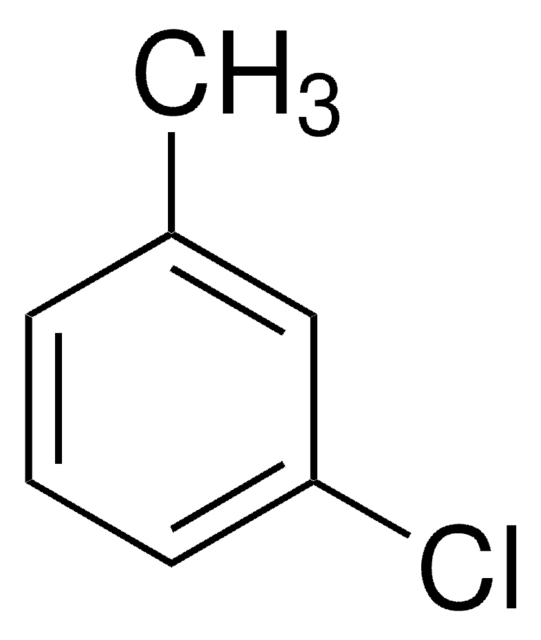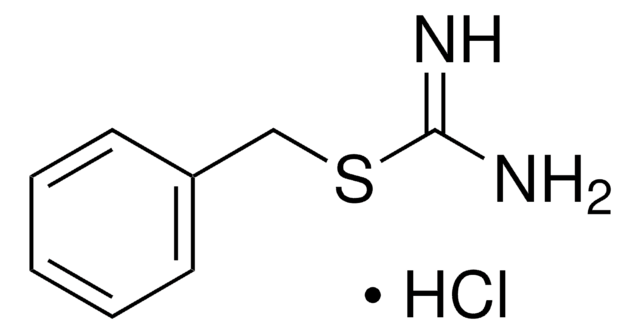C24604
3-Chlorobenzoic acid
ReagentPlus®, ≥99%
Synonym(s):
m-Chlorobenzoic acid
Sign Into View Organizational & Contract Pricing
All Photos(3)
About This Item
Linear Formula:
ClC6H4CO2H
CAS Number:
Molecular Weight:
156.57
Beilstein:
907218
EC Number:
MDL number:
UNSPSC Code:
12352100
PubChem Substance ID:
NACRES:
NA.22
Recommended Products
product line
ReagentPlus®
Assay
≥99%
form
powder
mp
153-157 °C (lit.)
SMILES string
OC(=O)c1cccc(Cl)c1
InChI
1S/C7H5ClO2/c8-6-3-1-2-5(4-6)7(9)10/h1-4H,(H,9,10)
InChI key
LULAYUGMBFYYEX-UHFFFAOYSA-N
Looking for similar products? Visit Product Comparison Guide
Related Categories
Legal Information
ReagentPlus is a registered trademark of Merck KGaA, Darmstadt, Germany
Signal Word
Warning
Hazard Statements
Precautionary Statements
Hazard Classifications
Eye Irrit. 2 - Skin Irrit. 2
Storage Class Code
11 - Combustible Solids
WGK
WGK 3
Personal Protective Equipment
dust mask type N95 (US), Eyeshields, Gloves
Certificates of Analysis (COA)
Search for Certificates of Analysis (COA) by entering the products Lot/Batch Number. Lot and Batch Numbers can be found on a product’s label following the words ‘Lot’ or ‘Batch’.
Already Own This Product?
Find documentation for the products that you have recently purchased in the Document Library.
Customers Also Viewed
T Ledger et al.
Microbiology (Reading, England), 155(Pt 8), 2757-2765 (2009-05-09)
Cupriavidus necator JMP134(pJP4) is able to grow on 3-chlorobenzoate (3-CB), a model chloroaromatic pollutant. Catabolism of 3-CB is achieved via the expression of the chromosomally encoded benABCD genes and the tfd genes from plasmid pJP4. Since passive diffusion of benzoic
Jens Dittmann et al.
Chemosphere, 49(3), 297-306 (2002-10-05)
The capability of different white rot (WR, Heterobasidion annosum, Phanerochaete chrysosporium, Trametes versicolor) and ectomycorrhizal (ECM, Paxillus involutus, Suillus bovinus) fungal species to degrade different aromatic compounds and the absorption of 3-chlorobenzoic acid (3-CBA) by ECM pine seedlings was examined.
Jennifer G Becker et al.
Applied and environmental microbiology, 72(1), 449-456 (2006-01-05)
Lengthy adaptation periods in laboratory studies evaluating the potential for contaminant biodegradation in natural or engineered environments may indicate that the native microbial communities are not metabolizing the contaminants in situ. In this study, we characterized the adaptation period preceding
Ian L Pepper et al.
Environmental health perspectives, 110 Suppl 6, 943-946 (2003-03-14)
Soils co-contaminated with metals and organics present special problems for remediation. Metal contamination can delay or inhibit microbial degradation of organic pollutants such that for effective in situ biodegradation, bioaugmentation is necessary. We monitored the degradation of 2,4-dichlorophenoxyacetic acid (2,4-D)
S Ramalingam et al.
Spectrochimica acta. Part A, Molecular and biomolecular spectroscopy, 84(1), 210-220 (2011-10-14)
The FT-IR and FT-Raman spectra of 3-chlorobenzoic acid (3CBA) are recorded in the liquid state. The fundamental vibrational frequencies, intensity of vibrational bands and the optimized geometrical parameters of the compound are evaluated using HF and DFT (LSDA/B3LYP/B3PW91/MPW1PW91) methods with
Our team of scientists has experience in all areas of research including Life Science, Material Science, Chemical Synthesis, Chromatography, Analytical and many others.
Contact Technical Service














